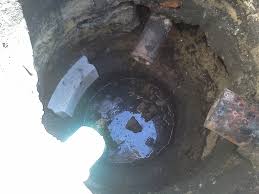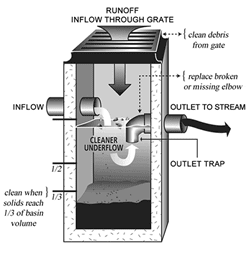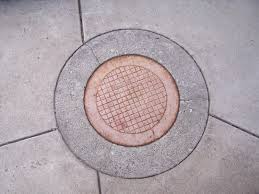Catch Basins
What is a Catch Basin?
A home built prior to 1960 and located in the urban areas of the larger cities is likely to have a cast iron lid on a large masonry basin. This basin is called a catch basin. There are many reasons for these large structures but the most common purpose of a catch basin is to separate the various contaminants in the residential sewer system.
Before we talk about catch basins we need to talk about the sewer system. Most older systems in older communities have a single pipe system. This system has both the sanitary and the storm sewers go through the same pipes to the same discharge locations. Modern communities and designs utilize a two pipe system, where the storm water is in one pipe and the sanitary sewer in another. The storm water would discharge to an appropriate location like a river or a lake, while the sanitary will terminate in some form of sewage treatment facility.
Older treatment facilities did not have the capacity or design ability to fully treat some of the grease, lye, and phosphates created from residential waste. Modern treatment facilities have the ability to treat these elements. In order to protect the system a trap or catch basin has been added to residential properties.
How is a Catch Basin Designed?
A catch basin is typical crafted from masonry. This masonry could be brick, concrete block or concrete rings. It is constructed deep enough to be lower than the bottom of the sewer system in the street, by a few feet. There are at least two pipes installed through the walls of the basin. One pipe is the inlet pipe from the home and the other is the outlet pipe toward the sewer. There may be other pipes as well. These could be the downspouts from the gutters or yard drains.
The idea is; the laundry, floor drains, and kitchen sinks are the most likely origin of the contaminated water. The toilets and bathrooms would discharge directly into the sewer and NOT through the catch basin. When the discharge enters the catch basin it would naturally separate. The solids would sink to the bottom. The gears scum and soap will float on the top. If the outlet pipe has a small elbow or bend it will only allow “clean” liquid to migrate out to the sewer system.
If the water levels are allowed to become unbalanced or too high the system will not work properly. This is typically because the scum layer is too high. There is an older term called a “muck bucket.” This is a small shovel or bucket on a pole. It was used to help clean out the scum or other debris accumulated at the bottom of the basin. The modern repair would be to have a sanitary vacuum truck clean out the system.
Because this system is installed to the laundry and the kitchen there is a strong opportunity for odors. Laundry and kitchen water is extremely malodorous. The installation of a garbage disposal is not encouraged. The organic materials will decay and provide the bad smell in the system.
How is a Catch Basin Inspected?
The inspection of the system should begin with the observations of the exterior elements. You have to verify the lid is safe and intact. Any cracks or damage to the lid can be potentially dangerous. There are two different types of lids.

The second element to the inspection is to review and look around the line and the concrete ring. This should be without any cracks or displacement. It should also be without any voids. Cracks in the ring can lead to lid failures. Voids or sink holes around the lid can be evidence of sidewall failure and erosions.
The interior of the catch basin should be reviewed. Attempt to identify any visible structural deficiencies to the sidewalls, such as visible distortions to the wall. The basin was constructed in a reasonably cylindrical manner. Any deviations to the cylinder should be noted. Next, the water level should be reviewed. The inlet pipe (from the home) needs to be higher than the water level.
An inspector should have the ability to determine if the catch basin is still an active part of the sewer system or has been removed from the system and is now vacated. There is a very easy way to determine this: turn on the water in the kitchen and laundry sinks. This water should be visibly discharging into the catch basin. If the water is not draining into the catch basin it is most likely vacated. Make sure to operate the system long enough to verify the system.
If the water level is higher than the inlet pipe there is a strong possibility of back up or slow drains in the home. The outlet pipe should be partially submerged in the water with the return under water.
Do Houses Need a Catch Basin?
A catch basin is no longer a necessity in modern homes. The older system can be removed from the system. It is a matter of reconfiguring the drains in the home and possibly adding an ejector system.
When a system is taken offline they are typically permanently sealed. This would include filling the basin with an appropriate material. This could include sand, stone, gravel or the combination of all of them. If you need help with other home care issues, be sure to check out our seasonal home maintenance checklist!

